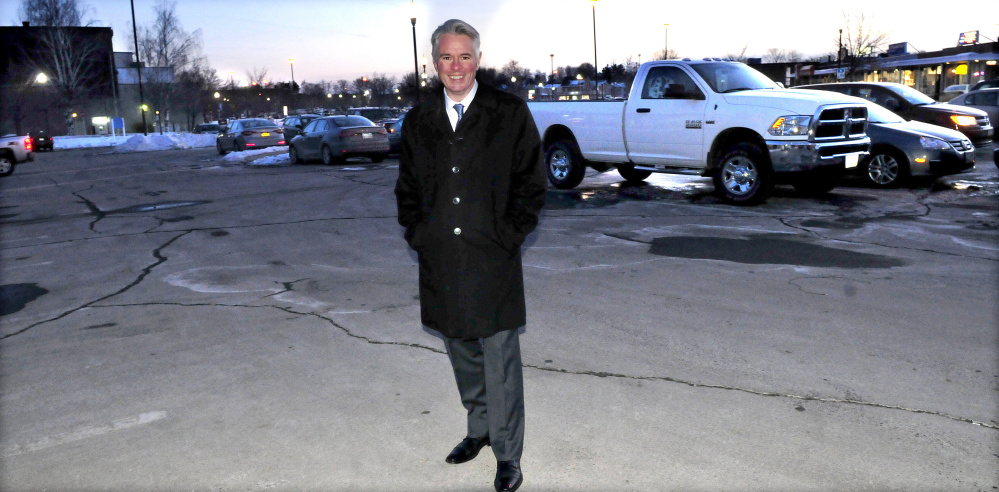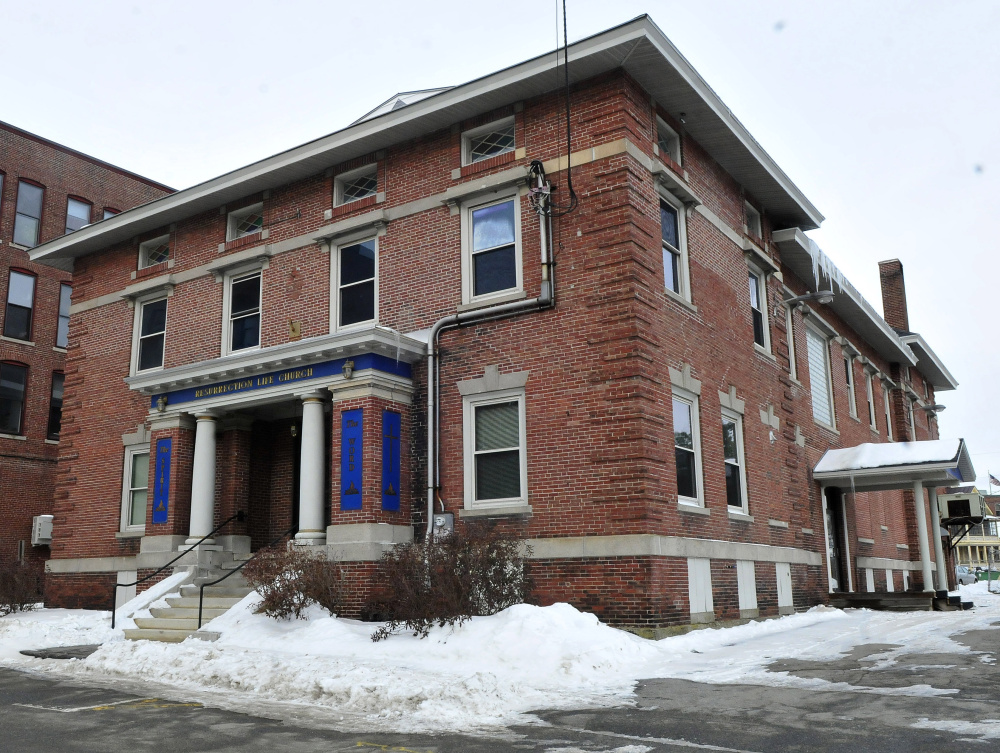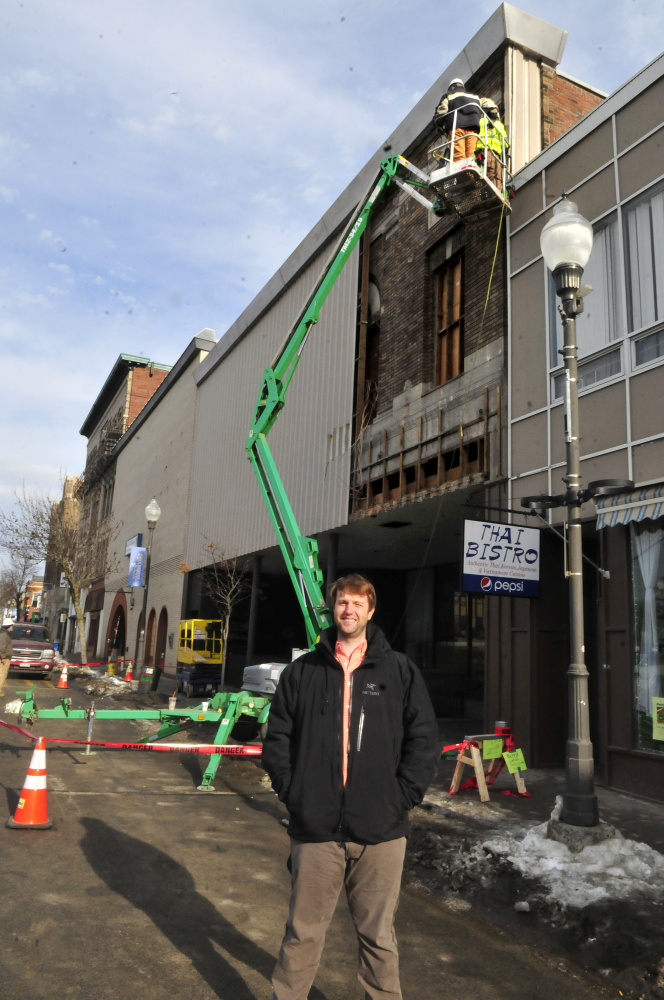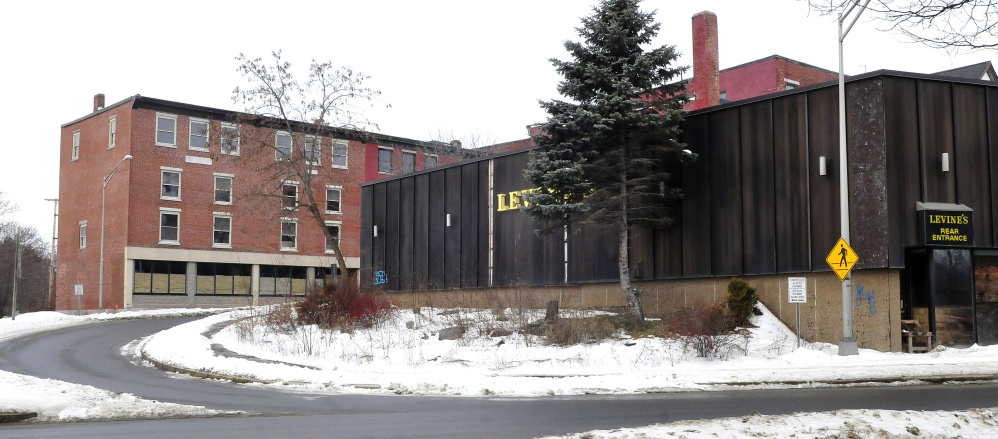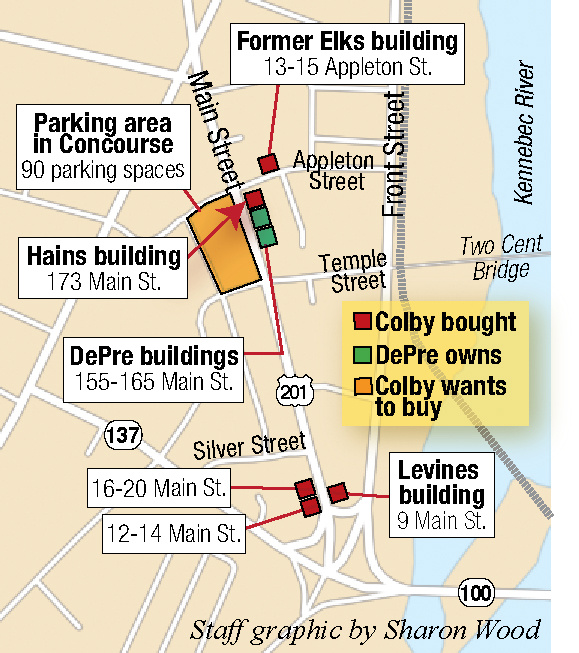WATERVILLE — Standing in the sprawling parking lot that abuts downtown, Colby College President David Greene said he envisions the drive-by area of The Concourse becoming a “walking street.”
As the college’s plan to buy part of The Concourse to build a student and faculty dormitory nears its final step, the college also has purchased yet another building downtown at 14 Main St.
If The Concourse plan receives city approval, “we’ll be able to move forward,” Greene said.
Across Main Street from the site of the proposed dormitory is the Hains building, which Colby bought and plans to renovate. In front of that building, Greene said, “You can imagine having this whole row of buildings brought back to life with destination retail across the street and both students and faculty and staff living in the space.
“It really starts to change the street dramatically.”
The plans are part of the college’s ongoing effort to help revitalize the heart of the city with new and refurbished buildings for commercial and residential use. Adding to the downtown resurgence, a Colby alumnus and his family recently bought and are renovating two more buildings on Main Street next to the Hains building.
The college’s latest purchase at 14 Main St. — the former Waterville Hardware — is at the other end of Main Street from The Concourse next to a building the college bought last summer. That makes a total of five downtown building purchases by the college in the past year.
City Manager Michael Roy said Tuesday that the city has set a price for The Concourse parcel, has submitted it to Colby officials and is awaiting a response. The City Council voted unanimously Jan. 19 to authorize Roy to start negotiating with Colby to sell the land.
If Colby agrees to the price, the City Council on Tuesday will consider selling the property to Colby and would take a second vote two weeks later, according to Roy.
If the city approves the sale, Colby would be in discussions with a developer for about six months and construction would occur in 2017 with completion and opening of the building occurring in the 2018-19 school year, Greene said.
‘A WALKING STREET’
Colby wants to build a dormitory to house up to 200 students and faculty and staff members in the northeast corner of the parking lot. The spot has 90 of The Concourse’s 600-plus parking spaces.
City officials have been told for decades that a building on that part of The Concourse would help revitalize downtown.
Several buildings in The Concourse area were torn down in the 1960s during urban renewal, and the businesses that were there, including The Villager restaurant, were moved back, leaving a wide gap on Main Street.
The Colby proposal, which probably would be four or five stories high, would have retail businesses on the first floor.
Greene said putting a building at the site with retail on the first floor would help create a “walking street” where people want to stroll, shop and eat. He said the gap now makes one want to get into a car and drive past it.
A new building would help create a different type of retail environment than currently exists on the street, as there would be larger, modern spaces on the first floor, he said.
The businesses would draw people to downtown, which then would drive more business, he said.
In addition, the students living in the dormitory at the site would be required to be engaged in the community, working with organizations such as Hardy Girls Healthy Women, as well as schools and possibly hospitals.
Colby students already work in the community at places such as the Mid-Maine Homeless Shelter.
“We want to build an entire program around civic engagement and community partnerships,” Greene said.
Greene said the Hains building at the corner of Main and Appleton streets was considered for a possible hotel, but other uses are being explored, such as a technology company with retail on the first floor and a business incubator for people developing new businesses on the second floor. Students could develop businesses there as well, he said.
“We have some proposals that we’ve just received for a hotel,” Greene said. “We’ve talked to developers who would be interested in doing the housing project.”
A CITY ‘SET TO GROW’
Next to the Hains building are the former Atkins Printing buildings at 155-165 Main St., which were bought recently by Thomas DePre and his sons, Thomas Jr. and Justin.
Justin DePre, a Colby alumnus, said the family plans to renovate the buildings to include retail and offices. Berry’s Stationers is in one of the buildings.
On Monday and Tuesday, workers from Lakeside Concrete Cutting Inc., of Newport, were removing the metal facade and wood framework on the southernmost DePre building, built in 1923, and exposing the original red brick and granite exterior.
Justin DePre, 33, was downtown Tuesday in the building that most recently housed Curves. He said he and his family are exploring possible uses for the two buildings.
“We’d love to get more retail shops in here and eventually a combination of office and residential on upper floors, too,” he said. “I just think Waterville is a very unique community and it has a lot of potential. Not only do we have Colby and Thomas colleges here, we also have hospitals and a lot of hardworking people.
“I don’t see a better town to invest in than Waterville. I don’t think any other town has all that going for it. I looked in Portland, I looked in Lewiston, and I just think Waterville is really set up to grow with the right coordinated efforts, and especially with Colby’s developments in the downtown.”
DePre graduated from Colby, where he majored in international studies and economics, in 2006. He also attended the University of Maine School of Law.
“I came to Colby and absolutely loved everything about Colby and Maine as well,” DePre said. He has refurbished four homes on Carroll Street that are occupied by Colby students.
The facade that workers were removing on one of his Main Street buildings this week was installed in the 1960s.
“One of the reasons we’re taking the facade off is, we’d like to potentially have the downtown historic district extended to the fire house if the city is interested in that,” he said.
Not only would he bring the building back to its historic nature, but he also would receive historic tax credits to work with.
Meanwhile, DePre praised Colby’s efforts to help revitalize downtown and said support from the community will be important to the effort. He said that while Waterville has lagged behind some Maine cities in terms of redevelopment, he believes Waterville’s downtown survived much longer than others because of the city’s unique characteristics.
Roy, the city manager, said Tuesday that the city is also fortunate to have the DePre family investing in Main Street.
The downtown was abuzz Tuesday with people talking about the removal of the facade on the former Atkins building.
Roy said the purchase and renovation of the buildings is “pretty exciting.”
“It’s very concrete step along with seeing the parts come off the building on Main Street,” he said. “That’s a pretty definite step that, yes, stuff is starting to happen.”
REVITALIZATION STRATEGY
Colby has been actively discussing plans for building renovations with developers, investors and contractors.
“We don’t have a developer under contract, but we’ve had very productive discussions,” Greene said Monday.
The latest of Colby’s five building purchases is the former Waterville Hardware — the southernmost building on the west side of Main Street before the intersection of Spring and Water streets.
Last year, Colby bought the building next to it at 16-20 Main St., a former tattoo parlor with apartments upstairs.
Across the street is the former Levine’s clothing store building, which Colby also bought last year and plans to either renovate or raze and construct a new building. Greene said the building has structural problems.
The college also recently bought the former Elks building at 13-15 Appleton St. near the Hains building.
“We don’t actually have a plan for that yet,” Greene said of that building. “As we looked in this lot (The Concourse) and this building (Hains), we knew that that spot could be potentially important, but we don’t know for what yet.”
Colby and city officials, as well as business leaders and others, met over several months last year to discuss ways to help revitalize the city; bring more people downtown to live, work and recreate; improve traffic flow; further develop the arts and culture; beautify the area and spur economic development. Drawing new businesses and helping those already here to thrive also was a priority.
The council also will be asked Tuesday to adopt a downtown revitalization strategy that spells out the goals and objectives developed by that group.
Those who attended the meetings cited as a priority the need to address vacant and deteriorating buildings downtown. In order to revitalize a downtown, they said, more people must be downtown 24 hours a day, seven days a week — not just working there, but living there as well.
After many meetings and much discussion, Colby started buying up the vacant buildings last summer with a plan to renovate them.
Downtown business owner Bill Mitchell, who had attended the meetings, followed suit and bought two historic buildings on Common Street, which he is renovating as offices, arts space and a possible restaurant. Mitchell, owner of GHM Insurance Agency, is a longtime supporter of revitalization efforts.
In addition to addressing vacant buildings and new construction, Colby also is partnering with the city and state Department of Transportation to study downtown traffic flow.
Reverting to two-way traffic on Main Street is a possibility, as is building a roundabout at the intersection of Main, Water and Spring streets to improve pedestrian access to Hathaway Creative Center on Water Street and make the intersection safer.
The city recently hired a traffic consultant, Gorrill Palmer Consulting Engineers, of Gray, for $102,000 to do the study, Roy said. The cost will be shared equally by the city, Colby and the transportation department.
Roy noted that much of what happens downtown in terms of work on buildings and other improvements is contingent on the results of the traffic and parking study, as well as whether two-way traffic is chosen for Main Street. The City Council would make that decision.
“That change would dramatically alter or affect all of those projects,” Roy said.
Amy Calder — 861-9247
Twitter: @AmyCalder17
Send questions/comments to the editors.


